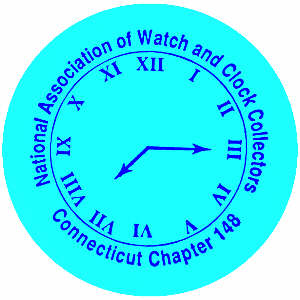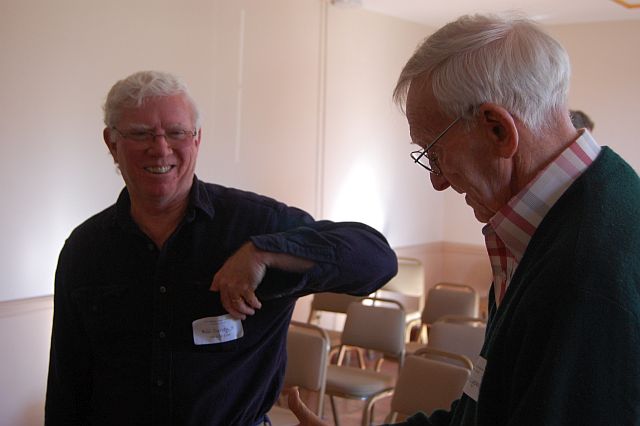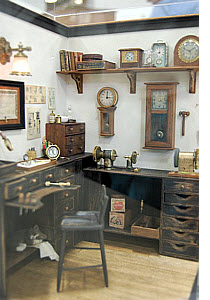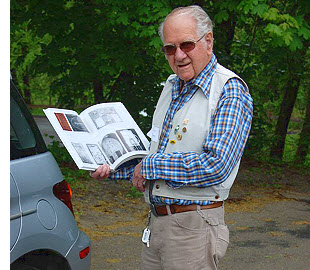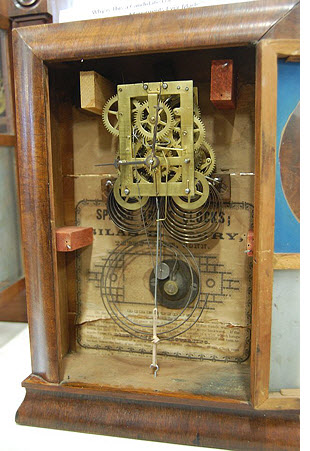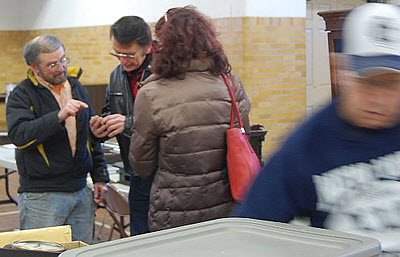Meetings PastNovember 21, 2015 Meeting Highlights Chapter 148 members and guests turned out in force for our November meeting, featuring mart, brunch, 50:50 raffle to benefit the American Clock & Watch Museum, a holiday gift basket raffle, and speaker. Our mart yielded many interesting finds. One such example was a rather uncommon Seth Thomas No. 7 "yacht" model ship's bell clock. A collector friend explained that, while the more commonly found No. 7's have bells on the bottom, and less common No. 7A's have deeper cases and interior bells, "yacht" model bells are located at the top of the clock, so the movement is essentially upside down. The clock's method of striking is also unusual. Two of the train wheels, including the locking wheel, are invariably found marked with red paint in the factory, so that assembly people could set the strike up with reasonable accuracy prior to passing the piece along to the shop adjuster. A removable bridge holding one of the wheel arbors functions to allow strike adjustments (if needed) without pulling apart the entire movement. Our guest speaker was chapter member Bill Curley, Jr. (CT), proprietor of Fixed in Time Clock Repair, whose topic was "Barrel Spring Repairs for Clocks". An expert machinist specializing in reproducing metal clock parts, Bill is also a member of both the American Watchmakers and Clockmakers Institute, and "Clocksmiths". His many years of experience in difficult to perform clock repairs were much in evidence during his talk. Bill began by explaining that, due to the high level of stress placed on winding arbors and their spring containment assemblies, repairs are frequently necessary. Broken springs, worn winding squares, missing barrel gear teeth, and myriad problems with spring hooks, are often encountered in the repair shop. For modern clocks (such as Seth Thomas mantle clocks), new barrel assemblies can often be purchased. After illustrating various barrel constructions found on older clocks, Bill proceeded to show how to bush a barrel, beginning with clamping the barrel to a plate with a bored sink to hold it the lathe, and to enable drilling an accurately centered new hole. Since the bottom barrel wall is often very thin, Bill solders the new bushing in for added strength, setting it inside the boss. He also typically turns a whole new bushing cap. If the hole for a spring hook is torn, there is usually no disadvantage to drilling a new hole on the other side without patching the old hole. The new hole is broached to taper, and slightly countersunk. Inserts to replace one or more broken teeth are made from scrap. First milling out a pocket in the damaged area, Bill files the corners before machining a tight push-fit patch, soldering the insert in place, then turning it up before machining the teeth. Bill gave very clear descriptions of (and excellent labor-saving tips for) additional repair procedures, including straightening deformed barrels, boring out the inside diameters of new barrels, obtaining the minimum number of cutters needed to make the vast majority of tooth sizes encountered, dealing with two piece barrel gears, cracked tubes, and bent arbors.
Bill Curley (on left) still discussing clock barrel repairs with an audience member after his talk. Many thanks are due to Bill for his efforts to generously share his expertise in the form of this presentation! Thanks are also due to the army of wonderful volunteers who made our chapter meetings educational and enjoyable over the past year! Happy holidays! * * * July 18, 2015 Meeting Highlights Chapter 148 met on the summery morning of Saturday, July 18. Despite sultry weather the meeting was well attended and vibrant. We were delighted to visit with several long lost friends, including John Bolton, Merrie London, Carol Rollins, and also our chapter's well-loved past president, Jim Katzin. We learned that chapter member Tom Grimshaw is recovering from heart valve replacement surgery. He is home and doing well, and is welcoming calls from clock and watch friends. The Plymouth Historical Society is hosting a "Clocks and Locks" walking tour at 6PM on August 8, 2015. Admission for the tour and a post-walk visit to the Historical Society's Museum is $5. (While you are there don't miss the chance to see the early steam engine, beautifully restored, and in working order!) The Old Terryville Cemetery on South Main St., Terryville, CT, in which Eli Terry, Sr., Eli Terry, Jr., Hiram Welton, and others who played key roles in the history of American clockmaking are buried, has long been a popular tourist destination for NAWCC researchers and clock collectors. It is in need of donations to help repair and appropriately replace portions of its historic cast iron fencing, which has suffered the depredations of nearly two centuries' worth of trees, derelict vehicles, and weather. Anyone wishing to help is encouraged to contact the Plymouth Historical Society, P.O. Box 176, Plymouth, CT 06782. Further information regarding the cemetery project, and about the above-mentioned walking tour, can be found on the Plymouth Historical Society's web site:
[click image for larger view} Chris Brooks brought a terrific early American Watch Co. pocket watch in a sterling silver case, graced by an early, probably original, miniature "monkey's fist" fob. Chris, an expert meter engineer with long experience in the field of maritime fuel storage and transport, explained that a "monkey's fist" was a knot, tied using exactly two fathoms of thick rope, around a piece of lead or other heavy material tucked inside. It was used to throw a heaving line ashore, followed by a hawser. The practice of using monkey's fists, however, was hazardous: many sailors who had been injured solved the problem by cutting them off the line ends. Thanks to all who helped make this a great meeting! * * * May 16, 2015 Meeting Highlights Chapter 148 met on the glorious spring morning of Saturday, May 16. Attendance was good, and trading at the mart tables brisk. Member Bob O'Connor (NY) shared some recollections and photos taken during various phases of Vassar College's William Bond & Son, Boston, chronograph restoration project, in which he, the late Mel Smith, the late James Storrow, and Aubrey Kinney were collaborators (see "Recent Research by James Storrow (NY) on the Historic Vassar College Chronograph", Research Activities & News, NAWCC Bulletin No. 399 (Sept./Oct. 2012), p. 533-4.) When found, the device (which dates to ca. 1861), was missing several pieces. Bob's stories dealt mostly with learning experiences shared with good friends (some now departed), and did not always end in triumphs. One example of this was the team's attempt to replace the chronograph recorder's missing drum. Starting with a piece of sheet brass, James had found a shop that was able to roll the brass into a 6" cylinder. The cylinder was then clamped together, and the team tried attaching 6" diameter brass discs to either end. Using a Rockwell milling machine with a Bridgeport head, the ends were milled and the cylinder brought to length. Next they attempted to turn the cylinder on a lathe, but it remained steadfastly out of round. Finally the problem was overcome by locating and purchasing a 6" diameter piece of brass tubing. Along with the challenges came some noteworthy successes. Producing the chronograph's missing weight and pendulum went smoothly. Then the device's escapement, which was also missing, had to be replicated. Lacking another example for measurement and study purposes, the team produced this delicate part from the chronograph's original plans miraculously discovered by James in the archives at Harvard University. Member Michael Davidson is making excellent progress on restoring the missing cornice and columns of a mid-19th century Seth Thomas shelf clock. He also brought a wonderful carriage clock discovered in a flea market during a trip to Spain.
* * * March 21, 2015 Meeting Highlights More than sixty Ch. 148 members and friends braved a spring snowstorm to attend our meeting on the morning of Saturday March 21. Despite less than ideal weather conditions, attendance was good and mart trading brisk. Our guest presenter was Tom Grimshaw (CT), whose unbelievably varied background is known to include engineering, teaching, ice cream making, and administration. Perhaps best known to chapter members, however, as an avid learner, lecturer, collector, and clock restorer, Tom's presentation was entitled "WHAT WERE THEY THINKING??" Intended as an exercise to develop engineering judgment and analysis skills, the program featured about one dozen remarkable (and often, understandably, rare) examples of American shelf clocks dating from approximately the 1830s to 1860s. These were set up with printed queries encouraging attendees to puzzle over (with Tom's assistance), ways in which the clocks' designs were poor...or in some instances, utterly impractical.
In the Ives category, for example, a round Gothic shelf clock with a tin plate movement (to reduce costs) required brass bushings and a costly roller escapement to attain functionality. An S.B. Terry 30-hr. brass time & strike movement had at least three times the number of parts as its Jerome's patent 30-hr. stamped brass analog, and probably had to be assembled in its case (click photo for larger view). An unlabeled shelf clock with an iron plate 30-day t&s movement attributed to Ives was also brass bushed; it had iron going barrels, iron chains, a roller verge, and a nice tablet...albeit one that had been installed inside out(!) An attractively carved paw foot S.B. Terry shelf clock had an equally attractive solid plate time & alarm movement, which suffers from the disadvantage of having to be taken completely apart to set the clock in beat. The presentation also featured an example of a rather ineffectual ca. 1860s "burglar alarm" clock. Many thanks are due to Tom for his efforts in bringing us this engaging and educational presentation! In addition, many thanks are due to all those who contributed generously of their time and effort to make our meeting an interesting and hospitable one! * * * January 17, 2015 Meeting Highlights
A well-attended "cabin fever" Chapter 148 meeting took place on the frigid Saturday morning of January 17, 2015. Activities included mart, raffle, and silent auction. We were pleased to welcome several new members and guests.
Chapter 148 members browse mart offerings at the January 2015 meeting. A very large 8-day 1920s-vintage Waltham pocket watch with a "spot indicator" in a little window on the dial that shows red when the spring is wound down, went home with a pleased new owner. Additional items spotted at the mart included a black Chelsea 15-day military or engine room timepiece in a Bakelite case with what looked to be an original stand; a 20th c Smith's "Cricklewood N.W. 2" English ship's clock; two Florence Kroeber, New York City shelf clocks, ca. 1890s, French styled with boulle trim, both in good original condition; a miniature ogee shelf clock bearing the label of Ansonia Clock Co. with "The Highland Chase" decalcomania tablet; a large ogee shelf clock bearing the label of "E. Manross, Forestville, Ct." with a brass movement and "Merchants' Exchange, Phila.[delphia]" tablet; and a German two-weight regulator. In addition, a Birge, Peck & Co., Bristol, Ct. triple-decker shelf clock with faux marbled half-columns and original Fenn tablets found a new home. Members sought and received help in identifying movements, and in proper repairing techniques for specific projects they are working on. The very happiest, healthiest New Year to all! * * * Meetings In 2014 |
